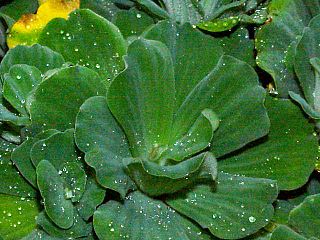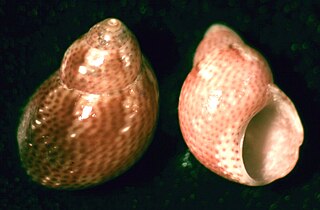
The lesser waterboatman or lesser water boatman is a water-dwelling insect of the order Hemiptera.

The western mosquitofish is a species of freshwater fish, also known commonly, if ambiguously, as simply mosquitofish or by its generic name, Gambusia, or by the common name gambezi. Its sister species, the eastern mosquitofish,, is also referred to by these names.

The lesser scaup is a small North American diving duck that migrates south as far as Central America in winter. It is colloquially known as the little bluebill or broadbill because of its distinctive blue bill. The origin of the name scaup may stem from the bird's preference for feeding on scalp—the Scottish word for clams, oysters, and mussels; however, some credit it to the female's discordant scaup call as the name's source. It is apparently a very close relative of the Holarctic greater scaup or "bluebill", with which it forms a superspecies. The scientific name is derived from Ancient Greek aithuia an unidentified seabird mentioned by authors including Hesychius and Aristotle, and Latin, affinis "related to", from its resemblance to the greater scaup.

Pistia is a genus of aquatic plant in the arum family, Araceae. The single species it comprises, Pistia stratiotes, is often called water cabbage, water lettuce, Nile cabbage, or shellflower. Its native distribution is uncertain, but probably pantropical; it was first discovered from the Nile near Lake Victoria in Africa. It is now present, either naturally or through human introduction, in nearly all tropical and subtropical fresh waterways and considered an invasive species as well as a mosquito breeding habitat. The genus name is derived from the Greek word πιστός (pistos), meaning "water," and refers to the aquatic nature of the plants.

Corixidae is a family of aquatic insects in the order Hemiptera. They are found worldwide in virtually any freshwater habitat and a few species live in saline water. There are about 500 known species worldwide, in 33 genera, including the genus Sigara.
Monoporeia affinis, formerly referred to as Pontoporeia affinis, is a small, yellowish benthic amphipod living in the Baltic Sea, the Arctic Sea and the lakes of the Nordic Countries.

Docodonta is an order of extinct mammaliaforms that lived during the Mesozoic, from the Middle Jurassic to Early Cretaceous. They are distinguished from other early mammaliaforms by their relatively complex molar teeth, from which the order gets its name. Until recently, Docodonta were represented primarily by teeth and jaws found across former Laurasia,. However, recent discoveries in China include some exceptionally well preserved, almost complete body fossils.
Tositumomab is a murine monoclonal antibody which targets the CD20 antigen produced in mammalian cell. It was combined with iodine-131 to produce a radiopharmaceutical for unsealed source radiotherapy, Iodine-131 Tositumomab, for the treatment of non-Hodgkins lymphoma. It is classified as a IgG2a lambda antibody.
Bathynomus affinis is a species of aquatic crustacean of the order Isopoda. It is known from the West Pacific (Philippines).

The black-chested jay is a species of bird in the family Corvidae.
The Curiche Grande River is a river of Mato Grosso state in western Brazil. It forms a portion of the international border between Brazil and Bolivia.
Water boatman as a type of aquatic insect can mean:

Eulithidium affine, common name the polka-dot pheasant or the spotted pheasant, is a species of sea snail, a marine gastropod mollusk in the family Phasianellidae.

Corixa is a genus of aquatic bugs in the family Corixidae. The fossil species C. elegans is from the Rott Formation in Nordrhein-Westfalen.
Apareiodon affinis, the darter characine, is a species of fresh water ray-finned fish native to the Río de la Plata Basin in southern Brazil, Paraguay and northern Argentina.

Corixinae is a subfamily of aquatic bugs in the family Corixidae. There are at least 130 described species in Corixinae.







